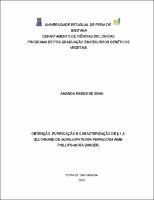| Compartilhamento |


|
Use este identificador para citar ou linkar para este item:
http://tede2.uefs.br:8080/handle/tede/1182| Tipo do documento: | Dissertação |
| Título: | Obtenção, purificação e caracterização de β1,3-Glucanase de Moniliophthora Perniciosa Aimephillipsmora (Singer) |
| Autor: | Sena, Amanda Reges de  |
| Primeiro orientador: | Assis, Sandra Aparecida de |
| Resumo: | A lavoura cacaueira vem enfrentando uma redução em sua produção desde 1989 com a chegada da doença denominada vassouradebruxa, causada pelo fungo Moniliophthora perniciosa. Entre as enzimas envolvidas no metabolismo do fungo, há a β1,3glucanase, que apresenta atividade lisozímica assim como o grupo das quitinases, as quais degradam polissacarídeos como βglucanos e a quitina, respectivamente. Neste sentido, objetivouse produzir, purificar, caracterizar, determinar parâmetros cinéticos da β1,3glucanase e estudar inibidores do crescimento micelial do fungo. Para a otimização da produção de β1,3glucanase utilizous 5 níveis de concentração de extrato de levedura e 3 níveis de tempo de fermentação através da Matriz Doehlert. Os valores ótimos preditos de indutor e dias de fermentação foram 5,9 g/L e 13, respectivamente. Os resultados revelaram três diferentes isoformas (GLUI, GLUII e GLUIII) com fatores de purificação de 4,33, 1,86 e 3,03, respectivamente. A enzima exibiu uma atividade catalítica ótima a pH 5 e 40ºC, sendo termoestável a 60ºC. A atividade enzimática foi maior a 0,2 mol/L e 0,6 mol/L na presença de NaCl e KCl, respectivamente. O extrato enzimático obtido do ponto central do planejamento foi utilizado para verificar a sensibilidade de duas Pseudozyma sp. à lise. O delineamento experimental mostrou que as melhores condições para a lise de Pseudozyma sp. (CCMB 300) foram a pH 4 e 20ºC e para Pseudozyma sp. (CCMB 306) a pH 5 e 40ºC. Buscando uma alternativa para o controle da vassouradebruxa Foram testados extratos de sete espécies vegetais (Marcetia latifolia, M. canescens, M. taxifolia, M. harley, M. formosa, Agave sisalana e Xanthium cavanillessi) nas concentrações que variaram de 250 a 4000 μg/mL. O extrato butanólico de A. sisalana e o extrato etanólico da folha de X. cavanillesii foram os mais ativos contra o fungo testado com poder de inibição de 100% a 4000 μg/mL e 500 μg/mL, respectivamente. Os resultados obtidos pela medida do CIM indicaram os valores de 500 μg/mL e 2500 μg/mL para o extrato da folha e caule de Xanthium cavanillessi, respectivamente. |
| Abstract: | The fungus Moniliophthora perniciousa causes a great reduction in production of cocoa crop since 1989 because is the agent causative of the disease known as witche’s broom. Among the enzymes involved in metabolism of the fungus, there is a β1,3glucanase, which has lysozyme activity and the group of chitinases,mwhich degrade polysaccharides such as βglucans and chitin, respectively. This work has the objective of purify, to characterize, determine the kinetic parameters and to study inhibitors on mycelial growth of Moniliophthora pernicious . In the optimization of production of β1,3glucanase was used five levels of yeast extract and three levels of fermentation time by Doehlert matrix. The predicted optimum values of inductor and fermentation time were 5.9 g/L and 13 days, respectively. The results showed three different glucanases isoforms (GLUI, GLUII and GLUIII) with purification factors of 4.33, 1.86 and 3.03, respectively. The enzyme exhibited an optimum catalytic activity at pH 5 and 40 ºC, and thermoestability at 60ºC. The activity was increased to 0.2 mol/L and 0.6 mol/L in the presence of NaCl and KCl, respectively. The enzyme extract obtained from the central point of the planning was used to verify the susceptibility of two Pseudozyma sp. to lysis. The experiment design showed that the best conditions to Pseudozyma sp. (CCMB 300) lyses were pH 4 and 20ºC and Pseudozyma sp. (CCMB 306) lysis were pH 5 and 40ºC. Looking for an alternative to controlling the witch’s broom, were tested extracts seven plant species (Marcetia latifolia, M. canescens, M. taxifolia, M. harley, M. formosa, Agave sisalana e Xanthium cavanillesii) at concentrations ranging from 250 to 4000 μg/mL. The butanolic extract from A. sisalana and the ethanolic extract from X. cavanillessi leaf were the most active against fungus tested with significant inhibition of 100% to 4000 μg/mL and 500 μg/mL, respectively. Results obtained by the measurements of MIC, indicate that the values are, respectively, 500 μg/mL for ethanol extract of the leaf and 2500 μg/mL for ethanolic extract of stem of X. cavanillesii. |
| Palavras-chave: | Enzima Cromatografia de exclusão molecular Características bioquímicas Parâmetros cinéticos Atividade antifúngica Lise enzimática Enzyme Size exclusion chromatography Biochemical characterization Kinetic parameters Antifungal activity Enzymatic lysis |
| Área(s) do CNPq: | CIENCIAS AGRARIAS CIENCIAS BIOLOGICAS |
| Idioma: | por |
| País: | Brasil |
| Instituição: | Universidade Estadual de Feira de Santana |
| Sigla da instituição: | UEFS |
| Departamento: | DEPARTAMENTO DE CIÊNCIAS BIOLÓGICAS |
| Programa: | Mestrado Acadêmico em Recursos Genéticos Vegetais |
| Citação: | SENA, Amanda Reges de. Obtenção, purificação e caracterização de β1,3-Glucanase de Moniliophthora Perniciosa Aimephillipsmora (Singer). 2010. 111 f. Dissertação (Mestrado Acadêmico em Recursos Genéticos Vegetais)- Universidade Estadual de Feira de Santana, Feira de Santana, 2010. |
| Tipo de acesso: | Acesso Aberto |
| URI: | http://tede2.uefs.br:8080/handle/tede/1182 |
| Data de defesa: | 25-Fev-2010 |
| Aparece nas coleções: | Coleção UEFS |
Arquivos associados a este item:
| Arquivo | Descrição | Tamanho | Formato | |
|---|---|---|---|---|
| 9amanda-reges-dissertacao-completa-25-02-2010.pdf | Arquivo em texto completo | 2,02 MB | Adobe PDF |  Baixar/Abrir Pré-Visualizar |
Os itens no repositório estão protegidos por copyright, com todos os direitos reservados, salvo quando é indicado o contrário.




